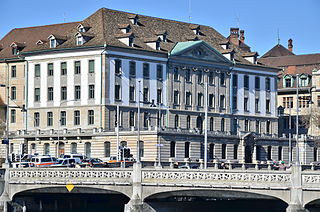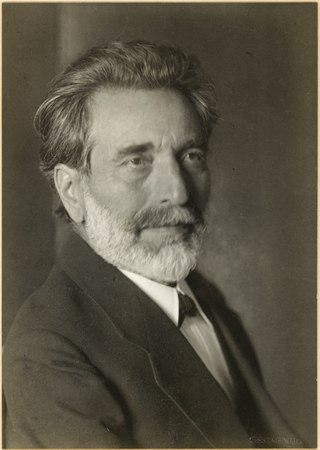Orell Füssli is a Swiss banknotes printing and bookselling company, established by Christoph Froschauer in 1519 as a book printer and publisher. It is currently operating in many print-related segments, such as security printing, bookselling and publishing, with security printing being a primary contemporary product of company. Company's shares are traded on SIX Swiss Exchange since 1897. It is the oldest continuously publicly traded company of Switzerland.
Max Pulver is the author of four graphology books, several articles, and one novel (1927). He developed the theory of symbolism of space. His work discusses pressure, intelligence, and crime. He founded the Schweizerische Graphologische Gesellschaft in 1950 and was president until his death.

The Barfüsserkloster in the old town of Zürich is a former Franciscan friary. It was first attested in the 1240s and was dissolved during the Reformation, in 1524. The friary was situated in the southeastern corner of the medieval city, between the Neumarkt and the Linden gates.
The German Orthographic Conference of 1901 took place in Berlin from 17 until 19 June 1901. The results of the conference became official in the German Empire in 1902. The standardized German spelling that resulted from the conference was largely based on the Prussian school spelling, but also on the Orthographic Conference of 1876.
Birgit Zotz is an Austrian writer, cultural anthropologist and an expert on the subject of hospitality management studies.
The following is a timeline of the history of the municipality of Zürich, Switzerland.

Casimir Pfyffer von Altishofen was a Swiss politician and jurist. He was mayor of Lucerne (1832–1835), President of the Swiss National Council (1854/1855) and five times President of the Federal Supreme Court.

Turicum was a Gallo-Roman settlement at the lower end of Lake Zurich, and precursor of the city of Zürich. It was situated within the Roman province of Gallia Belgica and near the border to the province of Raetia; there was a tax-collecting point for goods traffic on the waterway Walensee–Obersee-Zürichsee–Limmat–Aare–Rhine.

Dübendorf Military Airport was a military airfield of the Swiss Air Force northeast of Dübendorf in Switzerland, located east of Zürich.

Staatsarchiv Zürich, formally the Staatsarchiv des Kantons Zürich, are the state archives of the Swiss Canton of Zürich and its legal predecessors, in particular the former city republic of Zürich.

The Predigerkloster was a monastery of the Dominican Order, established around 1234 and abolished in 1524, in the imperial city of Zürich, Switzerland. Its church, the Predigerkirche, is one of the four main churches in Zürich, and was first built in 1231 as a Romanesque church of the then Dominican monastery. In the first half of the 14th century it was converted, the choir between 1308 and 1350 rebuilt, and a for that time unusually high bell tower built, regarded as the highest Gothic edifice in Zürich.
Hans Heinrich Schmid was a Swiss Protestant Reformed theologian, University Professor and University Rector.

Münsterbrücke is a pedestrian and road bridge over the Limmat in the city of Zürich, Switzerland. It is listed in the Swiss inventory of cultural property of national and regional significance. It is indirectly named after two Münster (minsters), the Fraumünster and Grossmünster.

Waisenhaus is the last remaining building of the Oetenbach nunnery, and houses today the police department of the city of Zürich in Switzerland.

The Reformation in Zürich was promoted initially by Huldrych Zwingli, who gained the support of the magistrates of the city of Zürich and the princess abbess Katharina von Zimmern of the Fraumünster Abbey, and the population of the city of Zürich and agriculture-oriented population of the present Canton of Zürich in the early 1520s. It led to significant changes in civil life and state matters in Zürich and spread to several other cantons of the Old Swiss Confederacy, and thus initiated the Reformation in Switzerland.

Johann II von Habsburg-Laufenburg was the Count of Habsburg-Laufenburg and later Count of the House of Rapperswil.

Johann Jacob Hess was a Protestant Swiss theologian and clergyman.

Haruthiun Tigran Abeljanz was a Swiss-Armenian chemist.

Gerold Meyer von Knonau was a Swiss geographer and historian whose most enduring contribution to scholarship may well have been his pioneering work between 1837 and 1858 as cantonal archivist for Zürich and the surrounding region.

Johann Jakob Breitinger was a Reformed pastor in Zürich, professor, antistes and politician.












